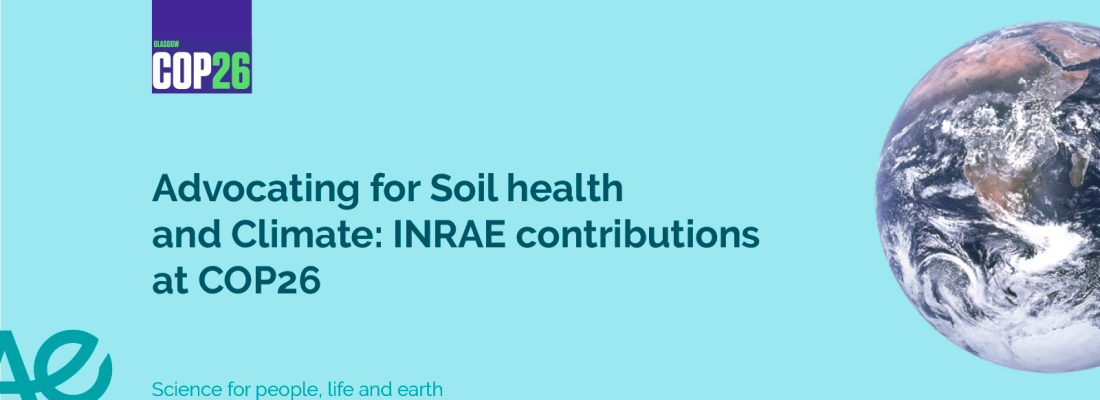Climate change and risks Reading time 3 min
Advocating for Soil health and Climate: INRAE contributions at COP26
Published on 15 November 2021

“In Glasgow, our delegation, along with our partners, brought forward several key messages and insights to push through the transitions needed in the Agriculture Forestry and Land Use sector. At INRAE, we pursue the ambition to bring about concrete solutions to major global challenges: climate change, food security, biodiversity, soil degradation and desertification, the depletion of natural resources.”
- Philippe Mauguin, CEO of INRAE
Soils are central to many of these challenges. The sequestration of carbon in soils, through positive agricultural practices – which benefit biodiversity and soil health - can help compensate greenhouse gas emissions (GHGs), thus mitigating climate change. In return, since soils that contain more carbon are more fertile, this can also benefit agriculture and global food security.
Our institute has long been taking a voluntary approach to promote research and innovation for carbon in soils, to bring concrete solutions on a multidimensional level. At COP26, we contributed to the debate by encouraging carbon farming for climate and soil health.
The 4 per 1000 initiative to promote carbon sequestration in soils on a global scale
The Initiative promotes science-based policies, actions and practices to preserve carbon stock and increase carbon sequestration in soils, fighting both food insecurity and climate change. An annual growth rate of 0.4% of carbon stocks - or 4‰ per year – in the top 30–40 cm of soil would significantly reduce the CO2 concentration in the atmosphere linked to human activity.
Since the Initiative was launched at the UN Climate Change Conference held in Paris in 2015 (COP21), progress has been made. The Initiative gathered in Glasgow on November 10, 2021 and presented the Strategic Plan and actions designed to start a new phase of operational implementation of the plan until 2050.
Watch Philippe Mauguin, INRAE CEO, highlight some projects we are conducting at the French, European and international levels to advance research and innovation on carbon sequestration in soils.
Ensuring socio-environmental integrity in the Land sector
To ensure safe and just pathways towards climate neutrality in the Agriculture Forestry and Land Use sector, researchers from CIRAD, IDDRI, INRAE and IRD delivered key messages in a policy brief introduced on November 6, in Glasgow, by Jean-Luc Chotte, IRD, representing IRD-INRAE-CIRAD.
They outlined 4 key messages:
- CO2 removal in the land sector and on a global scale will be limited, we need urgent and ambitious mitigation efforts
- Maintaining and increasing soil organic carbon stocks have multiple co-benefits
- Soil organic carbon stocks are finite, reversible and fragile
- We need inclusive and structured consultation processes for policy-making decisions

Transformation in all sectors of the economy must be framed to ensure the environmental integrity of carbon neutrality commitments as well as of trading mechanisms. Addressing simultaneously several challenges is needed.
Advancing Carbon Farming in Europe: what’s next?
INRAE researchers gave light to new research and innovation that are underway at the international and European level.
The European Joint Programme on Soils (EJP on soil): Coordinated by Claire Chenu, research director at INRAE, the EJP on soils will allow studying the technical potential of storing 4 per 1000 in soils in 20 European countries, Norway, Switzerland and Turkey.
The new European Soil Deal Mission: The Mission is led by Jean-François Soussana, Vice President of International Policy at INRAE. The European Union made commitments to restore soil health on over 70% of our land as well as commitments on soil carbon. Crop soils are losing carbon at a rate of 0.5% per year; 50% of drained peatlands are losing carbon – contributing to the climate crisis. He explained that “we need to conserve soil organic carbon stocks where they are high, increase carbon stocks where they are low in arable land and cut down loss of carbon in peatlands”.
The CIRCASA project: CIRCASA was coordinated by Jean-François Soussana with the goal to increase our ambition at a global level with the creation of an international research consortium on soil carbon.
CIRACASA: 4 priorities to build and international research consortium on soil carbon
- go beyond the frontiers of research by unlocking the potential with international research calls;
- assess soil carbon stocks through a Monitoring Reporting and Verification (MRV) system, setting an international standard;
- develop agroecological and technological innovations with private-public partnerships;
- enable environment and knowledge co-creation with open online collaborative platforms and co-design options.
One of the results of the CIRCASA project was a theoretical framework for MRV at a global scale. Eric Ceschia, research director at INRAE, stated that MRV prototypes are now under development but challenges remain. They need to be flexible, accessible with a huge volume of data to handle. There is also a need to ensure security, traceability and transparency of the approach, and to involve a large panel of potential users and stakeholders to define and ensure the largest possible accession.
Watch the replay “Carbon farming in a 2030 agenda for soil health and climate”
November 8 at COP26 in Glasgow on the European Commission Pavilion
